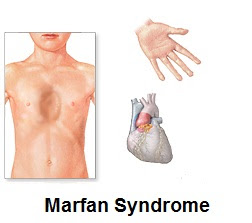What is Marfan syndrome?
People with Marfan syndrome have a defect on their connective tissue. The connective tissue is with them so weak it easy stretching or tearing. Connective tissue is everywhere in the human body. In Marfan syndrome is mainly the connective tissues in the joints, the eyes, the heart and the aorta is not strong enough.
What are the signs and symptoms of marfan syndrome?
Common symptoms in Marfan syndrome are:
- a curved spine (scoliosis);
- on movable joints;
- problems with the lens of the eye;
- problems with the heart valves;
- aortic dilatation.
By looking at these phenomena determines the physician that someone has Marfan syndrome. They also do a DNA test.
Most people with Marfan syndrome have the syndrome inherited from their parents. In about one third the syndrome spontaneously.
The syndrome is usually treatable with medication, physical therapy and surgery. People with Marfan syndrome should regularly go to the hospital for monitoring. This is particularly important for the problems with the aorta, and the lens of the eye.
Marfan syndrome is inherited?
Marfan syndrome is inherited. People with Marfan syndrome inherit the syndrome of their father or mother. This parent has the syndrome itself. This is called dominant inheritance.
But sometimes someone gets Marfan syndrome without his father or mother has it. This occurs in approximately one third of people with Marfan syndrome. This is called a spontaneous mutation. This spontaneous mutation is then again dominant hereditary.
The problem with Marfan syndrome is to not tell in advance how much it will be in the child. The child may have it worse than his or her parent, but also very less. They can tell you more about it at the Department of Clinical Genetics of the University Hospital. You can also go for prenatal diagnosis (test during pregnancy). With this research, the doctor can see if an unborn baby has Marfan syndrome.
If the expectant mother has Marfan syndrome, the doctor will inform the mother about the pregnancy well. Pregnancy is a big strain on the heart and vessels. Only if the condition of the mother is good, pregnancy justified.
What you notice Marfan syndrome?
People with Marfan syndrome often have a typical appearance:
- They have a long, thin body.
- They have long arms.
- They have long, thin fingers.
- They have a sunken chest, or a chicken breast.
- They have a curved back.
- They have long legs.
- They have flat feet.
- They have long, thin toes.
- on movable joints;
- an ever-widening aorta;
- leaky heart valves;
- a high and narrow palate;
- severe myopia;
- a sliding eye lens.
- subcutaneous wounds;
- glaucoma (intraocular pressure is too high);
- retinal detachment;
- a collapsed lung;
- an inguinal hernia.
Treatment for Marfan syndrome
Marfan syndrome is not curable. However, more and better options for treatment. Importantly, the annual monitoring in the hospital. Only way to prevent serious complications.
The doctor would particularly like to know if your aorta widens. This vessel could ultimately tear fact.
Also, your doctor will check valves every year. With an echocardiogram, the doctor may look at your heart and blood vessels well.
Sometimes you get for your aorta beta blockers. Because these drugs will slow the blood flow through the aorta.
If your aorta is too wide will the doctor operate. You also get surgery if your heart valves into bad practices.
An operation of the chest may be needed when your chest deviation becomes too severe. To counteract the curvature of the spine you get exercise, a corset or surgery.
Children who are extremely long threatened, sometimes gain growth inhibitory drugs.
Almost all people with Marfan syndrome need glasses. Furthermore, annual inspection at the ophthalmologist is important to detect eye problems quickly. A shift lens or a detached retina, the eye doctor can usually re-fix with an operation. The treatment of glaucoma (elevated intraocular pressure) is comprised of medications.


